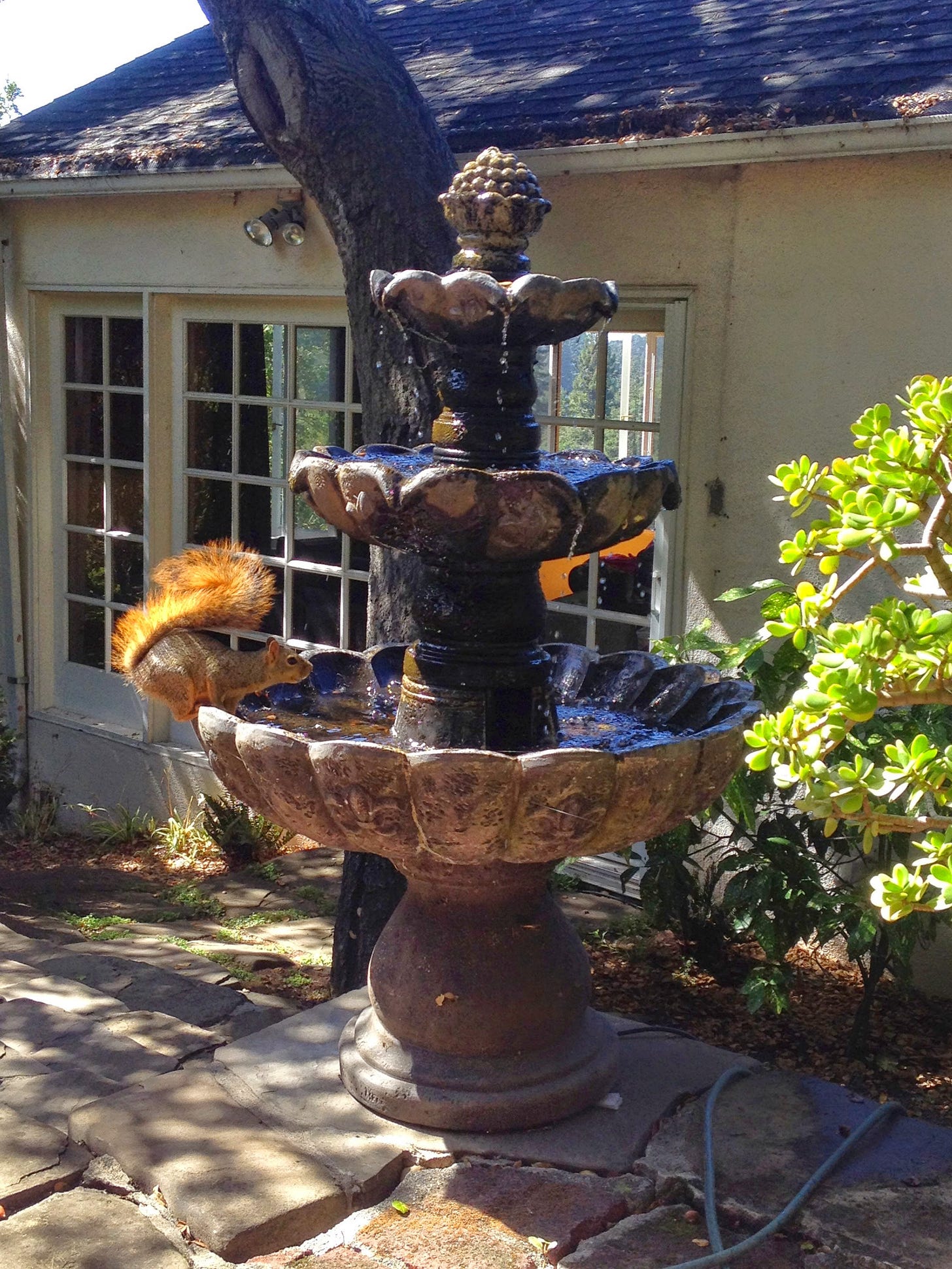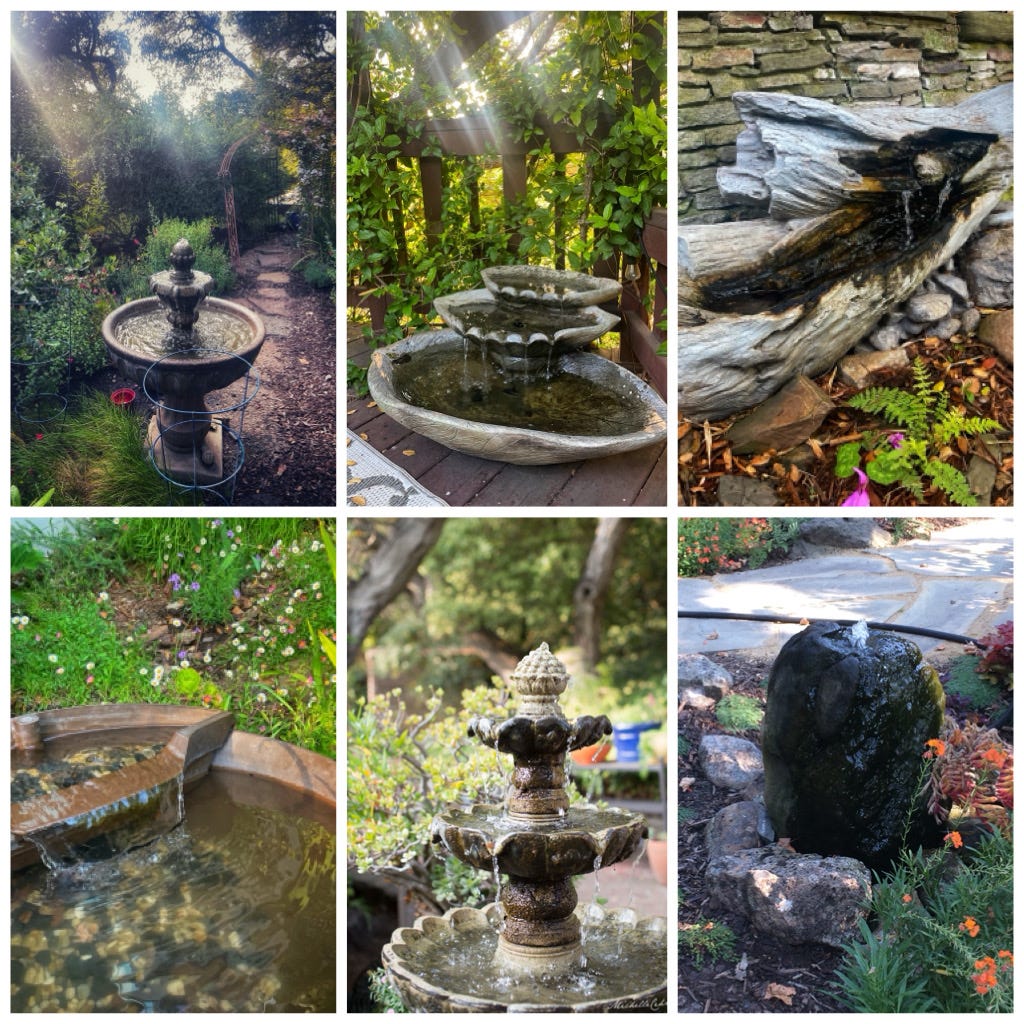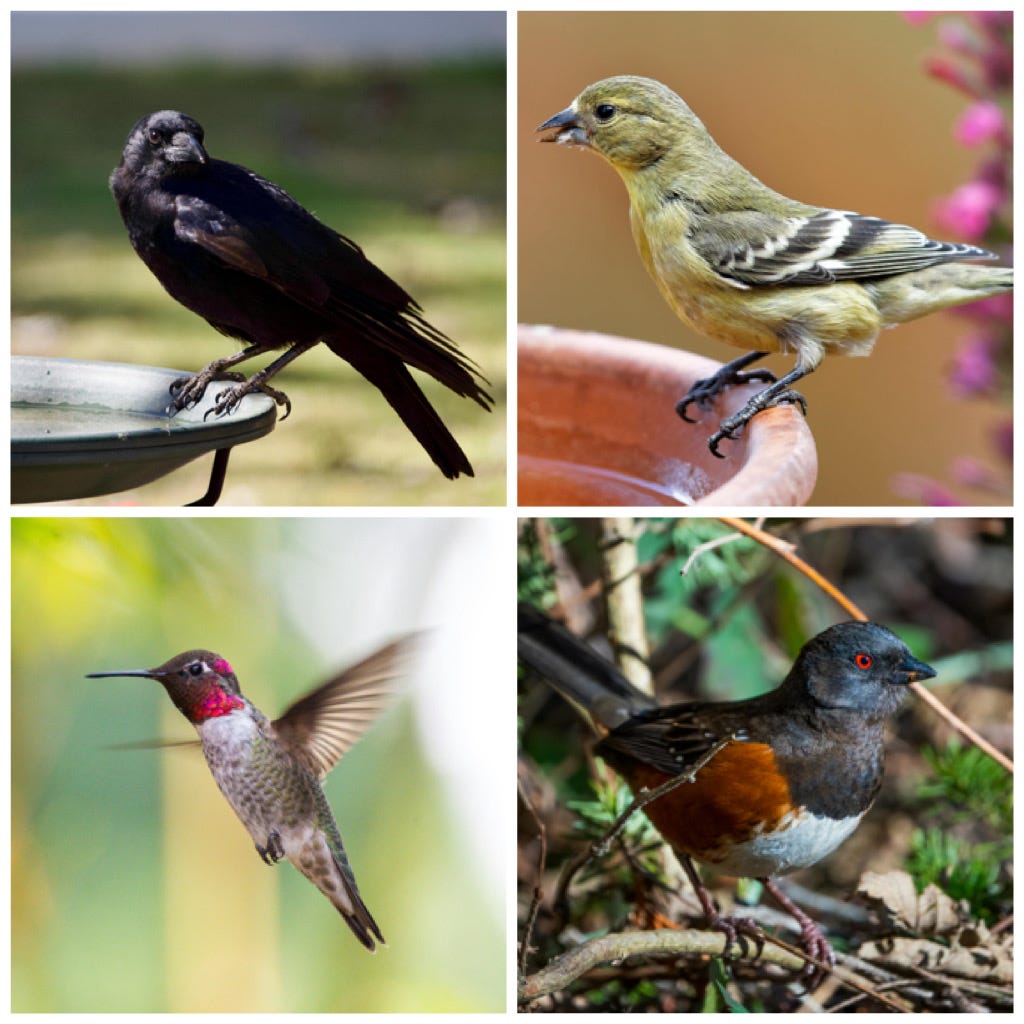Why I Don’t Use Bird Feeders — And What I Do Instead to Attract and Support Birds
One of the simplest and most essential ways to help birds, animals, and insects
You don’t need bird feeders to support wildlife—in fact, there’s a simpler way to make a real impact. For over a decade, I’ve been creating a safe, thriving space for birds, mammals, and pollinators—no mess, no fuss, no conflict—just one essential thing they all need. Thank you for adding a ❤️ or comment below!
For over 13 years, I’ve been focused on making our property a safe and welcoming space for wildlife. While I continue to expand the number of native plants we grow to support pollinators (see more articles in this series), this sanctuary isn’t just for the bees, bugs, and butterflies—it’s for everyone: squirrels, raccoons, deer, bats, opossums, skunks, and birds.
Every day, I see or hear around 25 different bird species—likely more I haven’t yet identified. From towhees and titmice to woodpeckers and sparrows, the diversity is remarkable. And none of them are here because I feed them. They’re here because I provide three essential things: water, habitat, and shelter.
Today, I’m focusing on the first—and one of the most vital—ways I support wildlife: water. But before I get into how I attract and care for birds (and other animals) this way, let me start with what I don’t do: I don’t feed the birds.
Bird Feeders
Years ago, at our previous home, I put up several bird feeders because I wanted to support and attract birds—but it wound up being more stressful than supportive. Like anyone who’s had feeders, I was constantly trying to deter the squirrels and the larger birds, like scrub and Steller’s jays. I also saw how the feeders created competition, not just between species, but among the birds themselves—causing tension and territorial disputes.
Even when I set out peanuts specifically for the squirrels and jays, they still went after the seeds meant for the birds, performing acrobatic feats to break into the feeders. It became a daily circus trying to keep everyone happy.
And because concentrated feeding areas make it easy for diseases like avian flu and salmonellosis to spread, I also constantly worried about keeping the feeders clean and never felt like I was doing enough to do so. Then there was the environmental impact—commercial birdseed is often packaged in plastic and shipped long distances, contributing to waste and unnecessary emissions.
Still determined to support birds, I put up those same feeders when we moved into this house—Little Montali—13 years ago. But before long, the same issues resurfaced, and I eventually gave up and passed the feeders along through Buy Nothing.
NOTE: While I don’t use bird feeders myself here in California, I recognize that in colder climates—especially during harsh winters—feeders may be helpful. When natural food sources are scarce, supplemental feeding can support birds through difficult months. If you do choose to put out feeders, it’s essential to keep them clean, space them out to minimize crowding, and regularly check for moldy or spoiled seed to prevent disease.
Of course, I still wanted to attract and support birds and other animals—but without conflict, harm, expense, or packaging. That’s when I realized I was already doing just that: by providing water.
Water for Wildlife
When we moved, we brought along the water fountain we already had—a beautiful, heavy, multi-tiered piece that recirculates water through three levels. We already knew the birds loved it, and the squirrels did too, so of course we took it with us to our new home.
Today, we have seven fountains of varying sizes and shapes placed throughout our property.
Water is essential—whether or not you live in a drought-prone state like I do—especially in dry climates and during the hot summer months. I’ve made water a cornerstone of my wildlife-friendly garden, and clearly, it works.
The fountains, bird baths, shallow trays, and large tubs attract a wide variety of animals—from busy bees and hummingbirds to jays, squirrels, and skunks. One of the larger tubs, which I keep full and fresh in a quiet corner of the garden, is especially popular with the deer and their fawns. We’ve come to call it “the watering hole,” because that’s exactly what it is. And at night, my trail cameras often capture a family of raccoons making their rounds—splashing, drinking, and stirring up all kinds of mischief.
Each type of water source serves a slightly different purpose:
the seven recirculating fountains offer movement and sound
the bird baths on pedestals provide safety and visibility
and the shallow ceramic trays on the ground allow easy access for insects, ground-feeding birds, and mammals alike.
Together, they provide consistent, clean, and accessible water for wildlife throughout the day and across the seasons. If you're thinking of adding water to your garden or yard, here are a few tips I’ve picked up over the years:
Water Fountain and Bird Bath Tips
Bird baths (and fountains) are best placed in the sun—birds prefer warm water and aren’t looking for a cold plunge!
Water trays and bird baths should be only partially filled—birds want to wade, not swim.
Large stones inside fountains are essential—they give young birds and insects a safe place to land or latch onto. I learned this the hard way after an unfortunate experience where a young bird drowned in our fountain. It happened only once and 20 years ago. Once I added large stones, it never happened again.
Birds need something nearby to hop on and off from—placing baths near a tree or shrub gives them a sense of safety. I’ve also added a couple of tomato cages next to the taller fountains, and the birds use them all the time for this purpose.
One more thing to mention—though it’s never been an issue for me—is cats. While my cat Michiko (and my beloved late cat Charlie) never went after birds, it’s something worth keeping in mind when creating a safe space for wildlife. If you're intentionally attracting birds to your yard, it's important to consider how to keep cats away from those areas—for the safety of the birds and the peaceful habitat you're trying to create.
Fountain Maintenance
Keeping fountains functional and clean is key to making them safe and inviting for wildlife. A good-quality pump is essential—cheaper ones may clog easily or burn out quickly. Even the best pumps may need to be replaced every couple of years depending on use. To prolong the life of your pump:
Clean out leaves and debris regularly
Rinse or scrub buildup around the intake
Place the fountain on a timer so it turns off at night (no need to run continuously). (If your fountains are off overnight, you might wonder whether mosquito larvae could become a problem. In general, as long as the water is moving during the warmer daylight hours, it’s unlikely that larvae will have enough time to hatch and mature. We’ven never had a problem.)
Of course, providing water for our co-habitants is a huge help to them—but the pleasure I get from watching them drink and bathe makes it clear this is a mutually beneficial experience. Since the birds are here every day and I’ve set up sitting areas nearby, it’s also the perfect opportunity to observe and identify them using my Merlin app.
Here is a list of the bird species I see (and hear) every day.
House Finch
Lesser Goldfinch
Spotted Towhee
California Towhee
Oak Titmouse
Bushtit
Bewick’s Wren
Song Sparrow
Mourning Dove
Anna’s Hummingbird
Hermit Thrush
Scrub Jay
Stellar’s Jay
American Crow
Common Raven
Nuttall’s Woodpecker
Downy Woodpecker
Black Phoebe
Dark-eyed Junco
Chestnut-backed Chickadee
American Robin
Red-tailed Hawk
Red-shouldered Hawk
Turkey Vulture
And then there are those just passing through—like the Ruby-crowned Kinglet and the Townsend’s Warbler—reminding me that this space isn’t just a home for our resident wildlife, but a resting spot for migrants along the way.
The joy that brings me is immeasurable.
Having clean, accessible water available year-round—especially during drought-prone seasons—may be the single most beneficial thing we can do for backyard wildlife. And in return, we’re gifted with their presence, their songs, and the quiet joy of sharing our space with them.
Read more articles in the backyard rewilding series.
More Resources for You!
👉 Work with me 1:1 – Get personalized guidance to build healthier habits, cultivate self-compassion, communicate with conviction, strengthen emotional resilience, or whatever you are looking for.
👉 Read A Year of Compassion – Daily inspiration to help you live with intention, kindness, and clarity
👉 Listen to Food for Thought – Inspiration for living compassionately, sustainably, and healthfully (18 years strong!)
👉 Travel with me! I host animal-friendly, luxury, all-inclusive vegan trips around the world, specifically curated to ensure high-quality, high-touch premium experiences. Check out our upcoming trips, and let me know if you have any questions.
👉 Because the publisher took The Vegan Table (and Color Me Vegan) out of print, I am able to repurpose all of my recipes for which I own the copyright again. Please check out my Recipe E-Books and my library of On-Demand Cooking Classes for more recipes.









I always enjoy your take on subjects that are widely accepted as examined and concluded and you just flip it over! This is reminds me of the bee keeping craze and how you noted that it's more important for environmental purposes to have plants that support the local bees rather than raise bees yourself. Your perspectives often bring about easier solutions too. Thank you!
We replace our feeders with water sources two years ago; however, we still do another type of bird feeder: hummingbird feeders. Hope you write a future article on this, I'm sure your habitat provides many natural sources of nectar.